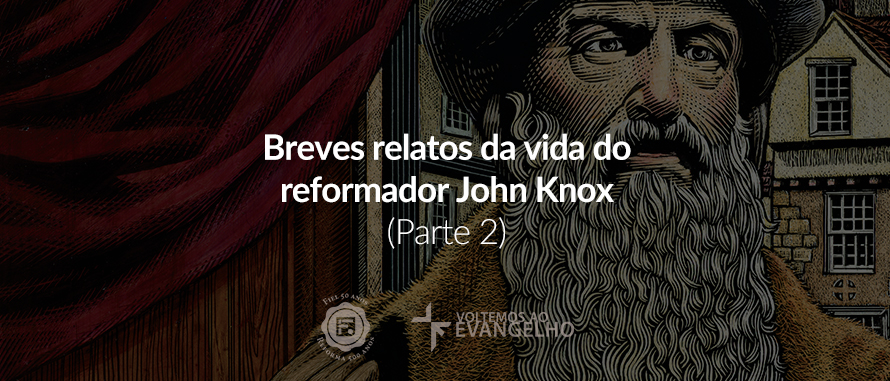500 years of Protestant reform
To celebrate the 500th anniversary of the Protestant Reformation, Return to the Gospel will present weekly articles and biographies of several reformers: Girolamo Zachi (January), Theodore Beza (February), Thomas Cranmer (March), Guilherme Farrel (April), William Tyndale (May), Martin Bucer (June), John Knox (July), Ulrico Zuonglio (there), Joo Calvino (set)
- Between 1553 and 1559.
- Knox lived in the same way as a nomad.
- He spent time with Calvin in Geneva.
- Calling him “Christ’s most perfect school?”From the days of the apostles.
- He then accepted a request to pastor the English-speaking congregation in Frankfurt.
- But there were problems arose about his vision of a church that should absolutely conform to New Testament standards.
In 1555, after another period in Geneva, Knox returned to Scotland to strengthen the reform work. He was particularly eager to encourage members of the Scottish nobility, whose commitment he feared would risk an easy commitment to Rome.
Knox married Marjory Bowes and in 1556 returned to Geneva, where he led a congregation of some two hundred refugees. The following year, did you receive an urgent invitation to return to Scotland?1558 was the time for the marriage of the young Mary, Queen of Scotland, to the Delfim of France, an event that seemed to be aimed at Scotland for a permanent Catholic government.
Forced by Calvin, Knox made a difficult and dangerous journey through the war zones in Dieppe, France, only to receive the news that some members of the nobility no longer felt the urgency of the situation (some of them were in fact in Paris at the time preparing Mary’s dreaded marriage). Knox’s response was to urge these “Lords of the Congregation” to form a common group (agreement or alliance), thus setting a precedent for the making of alliances among the pious Scots.
Evidence of Knox’s vigour can be seen in a letter he wrote to the people of Scotland that same year, encouraging them not to compromise the gospel. Knox reminded them that they would be held accountable in the court of God:
[Some apologise:] We were simple people, we were unable to repair the failures and crimes of our leaders, bishops, and clergy; We ask for reforms and desire them, but the lords’ brothers were bishops, their children were abbots, and the friends of the great men had possession of the church, so we were forced to obey all that they demanded. I tell you, it will do no good in the presence of God.
In 1558 Mary died, the “Bloodthirsty”, queen of England, replaced by Elizabeth I. Knox is looking for a safe path home through England. At the time, however, he was already known as the author of the infamous controversy against monarch women: the first trumpet outburst against the monstrous women’s regiment, which had been published anonymously,, in principle, in Geneva and put up for sale without Calvin’s knowledge. He was denied a safe means of passage, and went by boat. knox eventually arrived at Edinburgh Harbour, returning home to begin his most important phase of the indictment.
Despite his long absences from his home country, several things allowed Knox to lead the reform: his name was associated with the heroes of the recent past, his sufferings authenticated his commitment, his vast experience prepared him for leadership, and his sense of vocation. “fear of any man’s face. “
Knox gives a vivid account of these days in his History of the Reformation in Scotland. His famous audiences with Mary, Queen of Scotland, often distorted, attest to his fully committed to the principles of scripture. It is probably this total commitment that has brought it to In the early days, its radical vision had provided an opportunity for nobility to lead Scotland in the future, but many would have paid little attention to the radical transformation of the spiritual life of the Church and nation. As one modern scholar said: “The language of the covenant has been replaced by a more seductive image: the common good [welfare]. “
This change in Knox’s influence was illustrated in the coronation of the young James VI, where Knox preached the sermon, but the former Catholic bishop of Orkney atoned for the king according to ancient rites. The return of the bishops to the church was already announced.
In the summer of 1572, Knox was a shadow of himself. Weakened by a coup, he was beyond his power to preach at St. Giles Church, although he occasionally managed to do so in the vicinity of Tolbooth. In November, it was clear that he expected no more from this. world. On the morning of November 24, he asked his wife to read 1 Corinthians 15 to him, and around five o’clock his last request was: “Read where I put my first anchor,” certainly with faith; she read John 17. At the end of the night, he is dead.
Knox himself wrote with deep gratitude to God for the work he saw done:
With regard to the doctrine taught by our ministers and the administration of the sacraments performed in our Churches, we dare to affirm that today there is no kingdom on the face of the earth that has them in greater purity; yes (we have to tell the truth, no matter who we offend), right, anyone has them with a similar purity.
Many explanations have been given to Knox’s influence and the Scottish Reformation. There were certainly many factors in action in God’s providence that caused such spiritual renewal. But Knox’s conviction was: “God gave his Holy Spirit in great abundance to simple men. “This is the most important lesson in Knox’s life.

